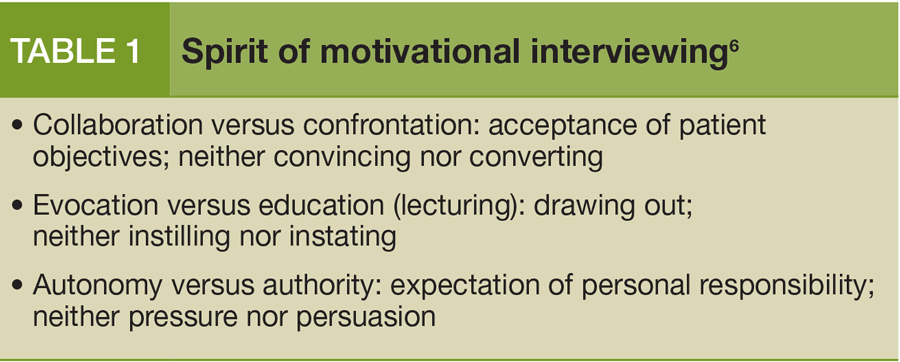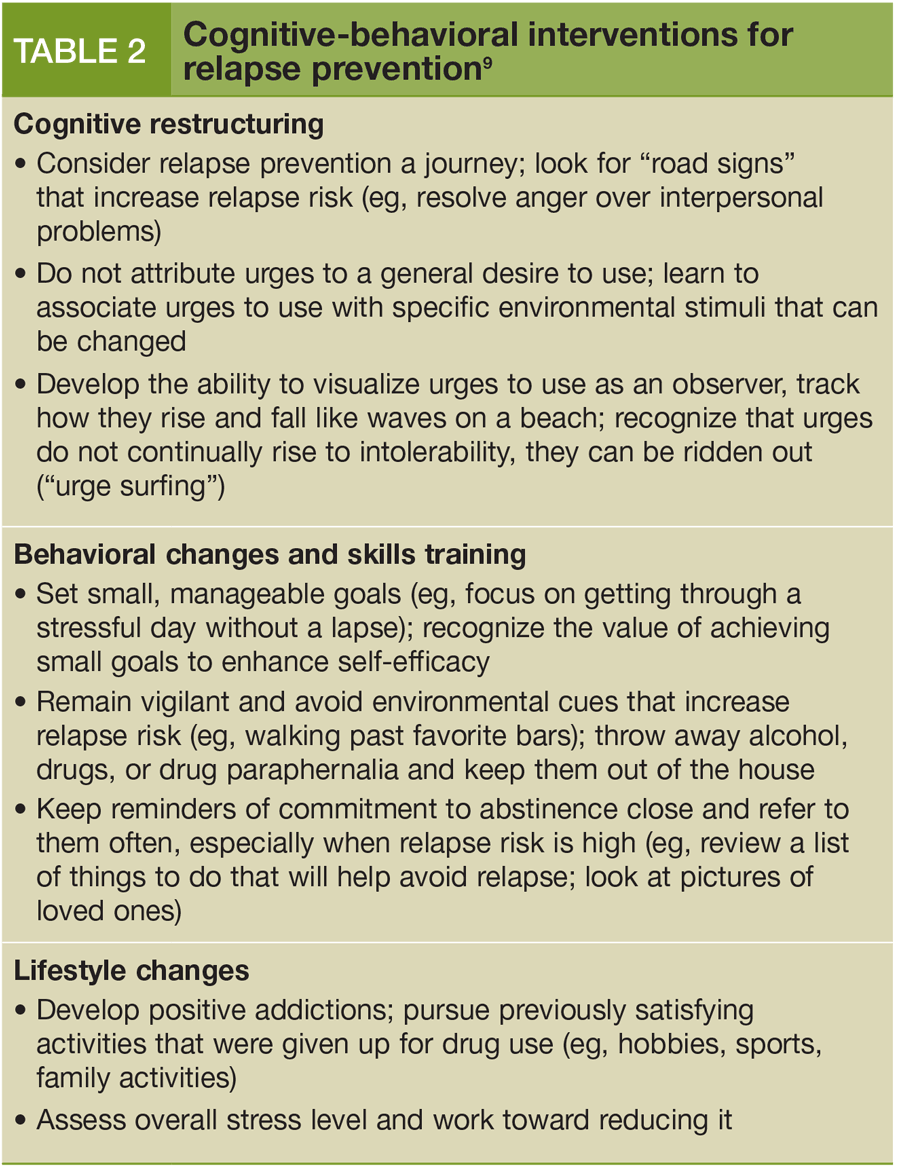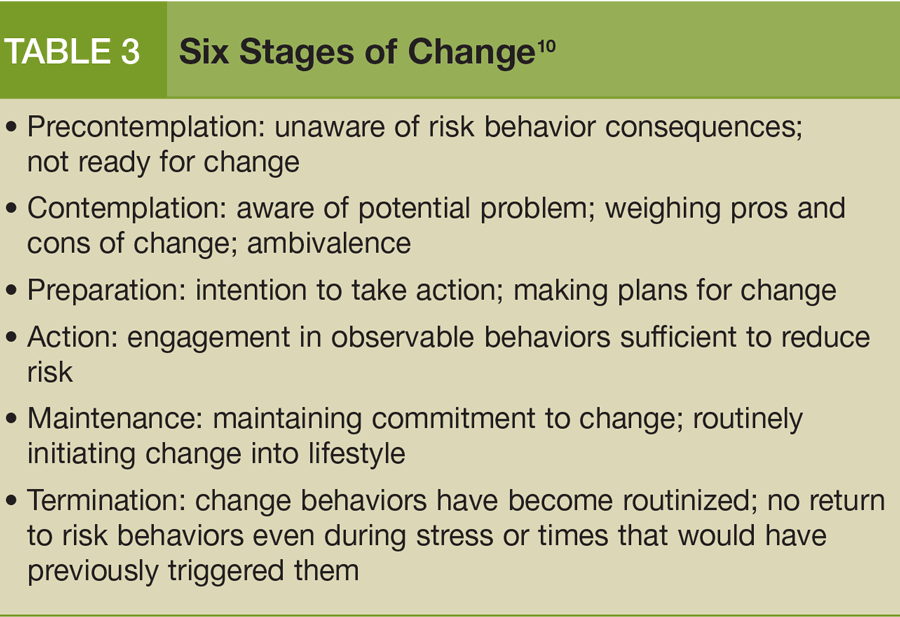
Publication
Article
Psychiatric Times
The Therapeutic Alliance and Psychosocial Interventions for Successful Treatment of Addiction
Author(s):
A discussion of treatment options to help foster the most effective psychosocial treatment for addiction.
TABLE 1

TABLE 2

TABLE 3

An effective approach to treating addiction hinges on the practitioner’s ability to engage and maintain patients in a high-quality therapeutic alliance. One recent study found that improvement in the quality of the therapeutic alliance during treatment contributes significantly to decreased alcohol use.1 Another review concludes that the content or model of therapy has little effect on improvement of substance-related outcomes, but the interpersonal qualities of the therapist-especially the capacity for empathy-can have significant effect.2 Furthermore, recent research reflects favorably on Freud’s early pronouncements that patients must be active collaborators in their treatment, and psychoanalytic constructs are critical to investigating the effect of the therapeutic alliance on treatment outcomes.3
Establishing a therapeutic alliance certainly involves controlling countertransference and maintenance of emotional neutrality because open, affect-laden displays of frustration, even disagreement, result in the patient’s perception that he or she is being judged. Such occurrences cause discord and degrade the therapeutic alliance. Beyond this, practitioners must be able to present feedback regarding their knowledge of addiction in a non-dictatorial manner while maintaining a highly personal relationship that allows them to show genuine satisfaction when their patients make positive health-oriented decisions.
The concept of the “holding environment” is probably the best metaphor for capturing the qualities of a good therapeutic alliance.4 The mother-child bond is based on love. The holding environment is created out of a mother’s desire to appropriately meet her child’s needs at each stage of development. Such nurturance includes supporting responsible behavior, self-reliance and, eventually, independence.
The therapeutic alliance is based on a practitioner’s personal mission to help others, genuine empathy, and respect for the patient’s autonomy and well-being. It is critical to express the belief that patients have the capacity and responsibility for the quality of their lives. This approach to treatment provides a powerful meta-message that patients are expected to develop self-efficacy, or the ability to be self-sufficient and assume responsibility for their own behavior.
In one recent report, self-efficacy is repeatedly shown to be an important predictor of treatment outcomes, and it is recommended that research efforts be stepped up to understand how it can be enhanced in treatment.5 When the therapeutic alliance is based on these principles, patients (with the possible exception of those with severe antisocial and narcissistic disorders) recognize the value of the therapeutic relationship and reciprocate with respect and positive regard.
Motivational interviewing
Motivational interviewing (MI) is the most effective psychosocial model for establishing the therapeutic alliance because the practice of MI reflects elements of the holding environment, including concern without judgment, a desire for patient success, and empathy.6 In fact, empathy is the most important practitioner quality for success in psychotherapy.7
When MI is used, patients view the practitioner differently from others in their lives who offer advice without understanding or simply attempt to coerce them to change. Concomitant with empathy and a non-judgmental attitude, MI practitioners relate to their patients as equal partners in the treatment process. Referred to as egalitarianism, this quality de-emphasizes the power issue associated with the classic physician-patient relationship and reduces patient resistance. This sense of equality also provides the patient with a clear indication that MI therapists do not consider themselves to have any authority over or responsibility for patient decisions and, importantly, for treatment outcomes. An MI-based approach reduces defensiveness and engenders trust; patients become willing to explore their ambivalence over maintaining the status quo versus initiating behavior change in their lives. The principles of MI are to:
• Express empathy
• Develop discrepancy between current behaviors and broader goals
• Avoid argumentation
• Roll with resistance
• Support self-efficacy
These practices promote a spirit of MI that is capsulized in Table 1.
Unless patients agree that one is needed, no agenda is imposed during MI sessions. Patients are invited to freely discuss what they consider to be important in the context of treatment. Using a conversational style, MI is a continual process whereby patients are encouraged to express their thoughts and feelings while the practitioner reflects potential meanings and emotions behind the statements. The MI process helps patients better understand themselves, gain greater clarity, weigh the pros and cons of change and, ultimately, resolve ambivalence. Patients decide whether they want to change their behavior and, if so, when and what to change. MI has been found to be very effective in all areas of health care and is now recommended as a standard approach for working with patients in all areas of medicine.8
Cognitive-behavioral therapy
CBT examines and restructures patient drug use experiences to improve proficiency in controlling situations that trigger relapse. CBT is the foundation of relapse prevention whereby patients develop plans and skills for avoiding substance use.9 The approach to relapse prevention is a functional analysis during which situations and experiences that elevate patient risk for continued substance use are examined. These comprehensive analyses account for the effects of physical surroundings, social context, and patient perceptions and emotions on decisions to use substances. Plans for avoidance of such situations can then be developed.
Other interventions can be used to help patients improve their ability to avoid unforeseen risks for substance use. For example, in-session role playing can be used to help patients develop assertiveness and drug refusal skills. Relapse techniques fall into 3 general categories: cognitive restructuring, skills training, and lifestyle changes. Table 2 provides examples of cognitive-behavioral interventions for relapse prevention.
Dialectical behavior therapy (DBT) is a variant of CBT, and models of DBT that focus on treatment for drug abuse have been developed.10 One difference between CBT and DBT is that DBT focuses on control of emotional dysregulation that leads to risk taking and self-destructive behavior. Unstable patients who present with extremes of behaviors and high potential for self-harm may respond best to DBT-based interventions.
It is important to note that patients must be willing to cooperate with the CBT-based techniques, which assume patient readiness for change. Yet, addicted patients are often highly ambivalent about giving up drugs, and it is important that they are not in an unwavering, precontemplative stage of change during which they are unwilling to consider ways of reducing drug use.11Table 3 provides a summary of the Stages of Change model.
Addicted patients frequently move in and out of these stages because of their ambivalence about drug use. Addiction specialists often substitute “relapse” for the “termination” phase because relapse occurs much more often than a complete and lasting resolution of substance-related symptoms. Furthermore, the relapse model accounts for the circular pattern of recovery, followed by relapse, that addicted patients often display. Stage of change is important because imposing a model of treatment that is counter to the patient’s view of his problem will create discord in the therapeutic relationship. As discussed, avoidance of discord is critical because maintenance of the therapeu-tic alliance is more important to positive outcomes than strict adherence to any particular treatment model.
This is not to say that CBT-based interventions cannot be used with patients who deny the significance of their drug use. However, to maintain trust in the relationship, the practitioner must be honest and transparent in presenting the recommendation for using a directive approach such as CBT. The therapeutic alliance can only be preserved when the patient’s right to refuse treatment with which he disagrees is respected.
In such situations, MI-based techniques are called for as a precursor to using directive techniques. For example, the therapist can ask permission to present his perspective on how CBT may be helpful and only proceed if the patient wants to hear it. In this way, the patient’s independence as a partner in the treatment process is preserved. Offering control to the patient in such situations usually results in the patient’s willingness to negotiate about the direction and content of treatment.
Contingency management
Contingency management (CM; sometimes referred to as motivational incentives) is a behavioral approach that receives consistent support for its effectiveness.12 CM consists of pairing a target behavior with an incentive to perform the behavior. Tangible items are offered as incentives when patients follow through with behaviors such as attending treatment sessions or providing drug-free urine samples. It is important to use incentives desired by the patient and to keep the targeted behaviors simple. Furthermore, expensive incentives are not necessarily better, and CM programs can be operated on a relatively small budget.
In clinical trials, groups exposed to CM have shown significant increases in treatment attendance, drug-free days, and providing drug-negative urine samples, compared with peer groups not exposed to CM.13,14 Support of CM effectiveness is so consistent that this approach has been proposed as part of a 6-point model that should be a standard and central practice in all treatment settings.15
CM is often used as an adjunctive therapy and can easily be adapted for use with other individual and group therapies. CM can be particularly valuable when working with patients who are not introspective and who are not otherwise good candidates for psychotherapy.
Twelve-step facilitation
Twelve-step facilitation (TSF) is a treatment that encourages patients to participate in the meetings and activities of self-help associations, primarily Alcoholics Anonymous (AA), Narcotics Anonymous (NA), and Cocaine Anonymous (CA). Formal models of TSF have been developed for major research initiatives, such as Project MATCH, for which 3 models of treatment-motivational enhancement therapy (MET), CBT, and TSF-were compared for effectiveness on alcohol use outcomes.16 All forms of treatment were found to be equally effective, but patients with more severe alcoholism responded better to TSF and continued to fare somewhat better at 3 years compared with patients treat-ed with MET or CBT.17
Recent research suggests that patients who consistently attend self-help activities and stay involved with a 12-step sponsor are more likely to remain abstinent from substances because they establish a social network that acts as a buffer in maintaining the lifestyle change necessary for staying substance-free.18 Self-help meeting attendance increases social support and self-efficacy, and this is effective against comorbid substance dependence and depression.19
Some patients refuse to attend self-help groups, and attendance should not be imposed because the therapeutic discord caused by the disagreement will compromise the therapeutic alliance. One technique for improving engagement is to recommend that patients consider meeting with someone who is an active participant-simply to learn more about the program.20 A study showed that inpatients exposed to a referral made by an active self-help group participant were more likely to attend self-help meetings following their discharge than were inpatients who received the intervention by their doctors.21 Therefore, it is advisable to develop a registry of people who are active in 12-step programs and request their help by meeting with patients who are willing to consider getting started in self-help activities. Donovan and Floyd22 provide an excellent review of techniques for increasing attendance in 12-step programs.
It is critical to recognize that the processes of formal psychotherapy and 12-step programs are very different, and patients will often retell stories of being critically confronted by their self-help peers. This is standard fare in the 12-step community, and practitioners should support the efforts of self-help communities, especially when patients report on peer and sponsor behavior. When patients find their self-help group experiences upsetting, reframing them to suggest that their 12-step peers may have well-meaning motives often leads patients to consider working through their frustration rather than stopping their participation in self-help groups. The combination of the different approaches (ie, practitioners in formal treatment and peers in self-help groups) can provide a synergy beneficial to patient motivation for maintaining the lifestyle change necessary to remain drug-free.
Although AA, NA, and CA are the most widely practiced versions of self-help, TSF is a highly structured treatment, and implementing a full version of the therapy may be difficult in office practice. Other self-help organizations, such as Smart Recovery, Women for Sobriety, and Secular Organizations for Sobriety, offer face-to-face and online support and are good alternatives.
Treatment planning with emphasis on dual disorders
The most important element of treatment planning involves increasing the intensity of treatment in conjunction with severity of condition. Treatment by one practitioner in a private practice can be effective for patients with substance abuse or conditions that do not involve physical dependence. However, moderate to severe physical addictions generally require intensive group therapies usually not available in single-practice settings. Notwithstanding the setting, modes and models of treatment can be combined. Randomized clinical trial results support the effectiveness of combined treatment models when compared with single-model treatment or treatment as usual.23
Treatment of dual disorders can be complicated when patients focus on non–substance-related symptoms, such as depression and anxiety. Practitioners recognize that depression and anxiety are exacerbated by intoxication and withdrawal, and they can be improved or reversed if treatment focuses on reducing drug use. However, patients are often not in a stage of change to accept the negative effects of drug use and expect to be treated for non–drug-related symptoms. It is not necessary to openly argue the point if a good therapeutic alliance has been established.
Using MI shows concern as patients review their symptoms. The practitioner’s empathic reflections create emotional support that are themselves curative, especially in the early stages of treatment. While offering such support, skilled practitioners can provide feedback that reframes the patient’s perception so that he eventually accepts the negative effect drugs exert on depression and anxiety. This approach helps patients realize the need to reduce drug use as part of their recovery. As needed, pharmacotherapy can be used for a more complete remission of non–substance-related symptoms.
Conclusion
The most important element of psychosocial treatment of addiction is the therapeutic alliance, and MI is critical for establishing that alliance. Other therapies, such as CBT, TSF, and CM, can be added to treatment. One perspective on this approach to treatment planning is that MI becomes the process by which therapy is delivered, while other models of treatment provide the content used in treatment. Such integration of treatments results in a dynamic process and a synergistic effect that offers the most effective psychosocial treatment for addiction.
Disclosures:
Dr Kelly is Clinician Emeritus, University of Pittsburgh School of Medicine, Western Psychiatric Institute and Clinic, Pittsburgh. He reports no conflicts of interest concerning the subject matter of this article.
2 Commerce Drive
Cranbury, NJ 08512
All rights reserved.





